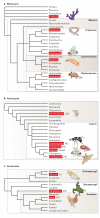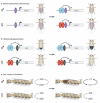Sex and the singular DM domain: insights into sexual regulation, evolution and plasticity
- PMID: 22310892
- PMCID: PMC3595575
- DOI: 10.1038/nrg3161
Sex and the singular DM domain: insights into sexual regulation, evolution and plasticity
Abstract
Most animals reproduce sexually, but the genetic and molecular mechanisms that determine the eventual sex of each embryo vary remarkably. DM domain genes, which are related to the insect gene doublesex, are integral to sexual development and its evolution in many metazoans. Recent studies of DM domain genes reveal mechanisms by which new sexual dimorphisms have evolved in invertebrates and show that one gene, Dmrt1, was central to multiple evolutionary transitions between sex-determining mechanisms in vertebrates. In addition, Dmrt1 coordinates a surprising array of distinct cell fate decisions in the mammalian gonad and even guards against transdifferentiation of male cells into female cells in the adult testis.
Figures




References
-
- Marin I, Baker BS. The evolutionary dynamics of sex determination. Science. 1998;281:1990–1994. - PubMed
-
- Williams TM, Carroll SB. Genetic and molecular insights into the development and evolution of sexual dimorphism. Nature Rev. Genet. 2009;10:797–804. - PubMed
-
- Zarkower D. Establishing sexual dimorphism: conservation amidst diversity? Nature Rev. Genet. 2001;2:175–185. - PubMed
-
- Wilkins AS. Moving up the hierarchy: a hypothesis on the evolution of a genetic sex determination pathway. Bioessays. 1995;17:71–77. - PubMed
Publication types
MeSH terms
Substances
Grants and funding
LinkOut - more resources
Full Text Sources

